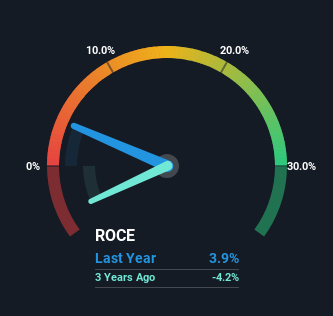- Australia
- /
- Trade Distributors
- /
- ASX:BOL
Boom Logistics (ASX:BOL) Might Have The Makings Of A Multi-Bagger

There are a few key trends to look for if we want to identify the next multi-bagger. In a perfect world, we'd like to see a company investing more capital into its business and ideally the returns earned from that capital are also increasing. If you see this, it typically means it's a company with a great business model and plenty of profitable reinvestment opportunities. Speaking of which, we noticed some great changes in Boom Logistics' (ASX:BOL) returns on capital, so let's have a look.
What Is Return On Capital Employed (ROCE)?
Just to clarify if you're unsure, ROCE is a metric for evaluating how much pre-tax income (in percentage terms) a company earns on the capital invested in its business. Analysts use this formula to calculate it for Boom Logistics:
Return on Capital Employed = Earnings Before Interest and Tax (EBIT) ÷ (Total Assets - Current Liabilities)
0.039 = AU$5.0m ÷ (AU$207m - AU$78m) (Based on the trailing twelve months to June 2023).
Therefore, Boom Logistics has an ROCE of 3.9%. In absolute terms, that's a low return and it also under-performs the Trade Distributors industry average of 11%.
See our latest analysis for Boom Logistics

While the past is not representative of the future, it can be helpful to know how a company has performed historically, which is why we have this chart above. If you're interested in investigating Boom Logistics' past further, check out this free graph of past earnings, revenue and cash flow.
What Can We Tell From Boom Logistics' ROCE Trend?
It's nice to see that ROCE is headed in the right direction, even if it is still relatively low. We found that the returns on capital employed over the last five years have risen by 166%. That's not bad because this tells for every dollar invested (capital employed), the company is increasing the amount earned from that dollar. Interestingly, the business may be becoming more efficient because it's applying 29% less capital than it was five years ago. If this trend continues, the business might be getting more efficient but it's shrinking in terms of total assets.
On a side note, we noticed that the improvement in ROCE appears to be partly fueled by an increase in current liabilities. The current liabilities has increased to 38% of total assets, so the business is now more funded by the likes of its suppliers or short-term creditors. It's worth keeping an eye on this because as the percentage of current liabilities to total assets increases, some aspects of risk also increase.
The Bottom Line
In summary, it's great to see that Boom Logistics has been able to turn things around and earn higher returns on lower amounts of capital. Since the total return from the stock has been almost flat over the last five years, there might be an opportunity here if the valuation looks good. So researching this company further and determining whether or not these trends will continue seems justified.
One more thing, we've spotted 1 warning sign facing Boom Logistics that you might find interesting.
While Boom Logistics may not currently earn the highest returns, we've compiled a list of companies that currently earn more than 25% return on equity. Check out this free list here.
Valuation is complex, but we're here to simplify it.
Discover if Boom Logistics might be undervalued or overvalued with our detailed analysis, featuring fair value estimates, potential risks, dividends, insider trades, and its financial condition.
Access Free AnalysisHave feedback on this article? Concerned about the content? Get in touch with us directly. Alternatively, email editorial-team (at) simplywallst.com.
This article by Simply Wall St is general in nature. We provide commentary based on historical data and analyst forecasts only using an unbiased methodology and our articles are not intended to be financial advice. It does not constitute a recommendation to buy or sell any stock, and does not take account of your objectives, or your financial situation. We aim to bring you long-term focused analysis driven by fundamental data. Note that our analysis may not factor in the latest price-sensitive company announcements or qualitative material. Simply Wall St has no position in any stocks mentioned.
About ASX:BOL
Boom Logistics
Provides lifting solutions to mining and resources, infrastructure and construction, wind, energy, utilities, industrial maintenance, and telecommunications sectors in Australia and the Pacific region.
Good value with adequate balance sheet.
Market Insights
Community Narratives



